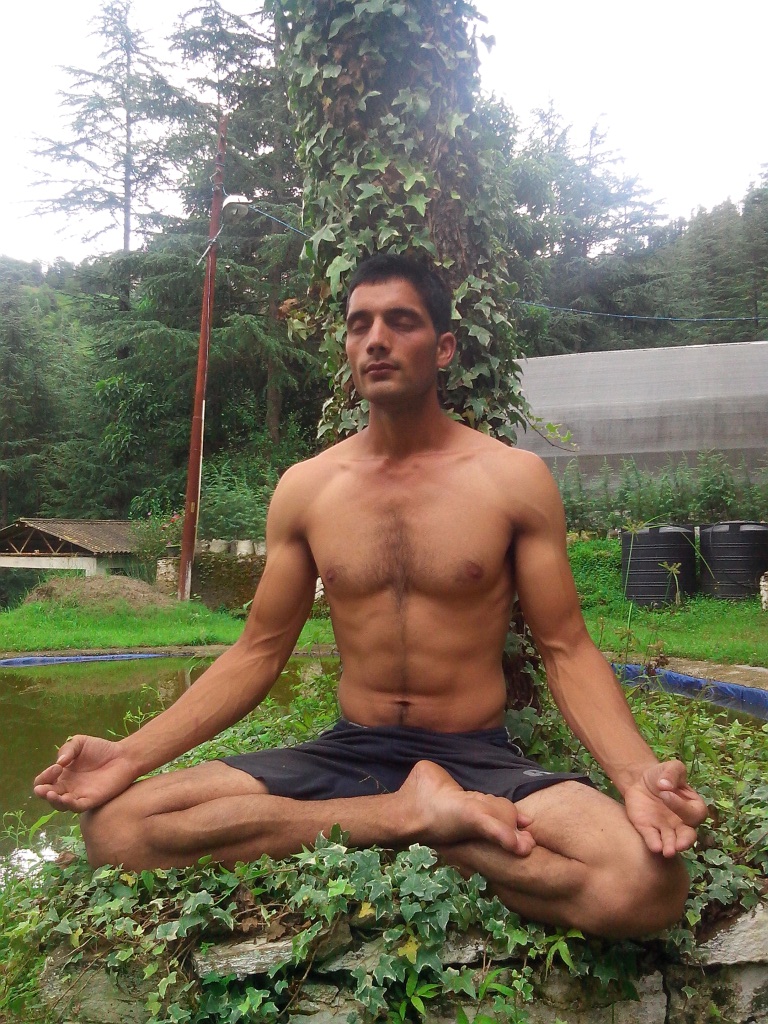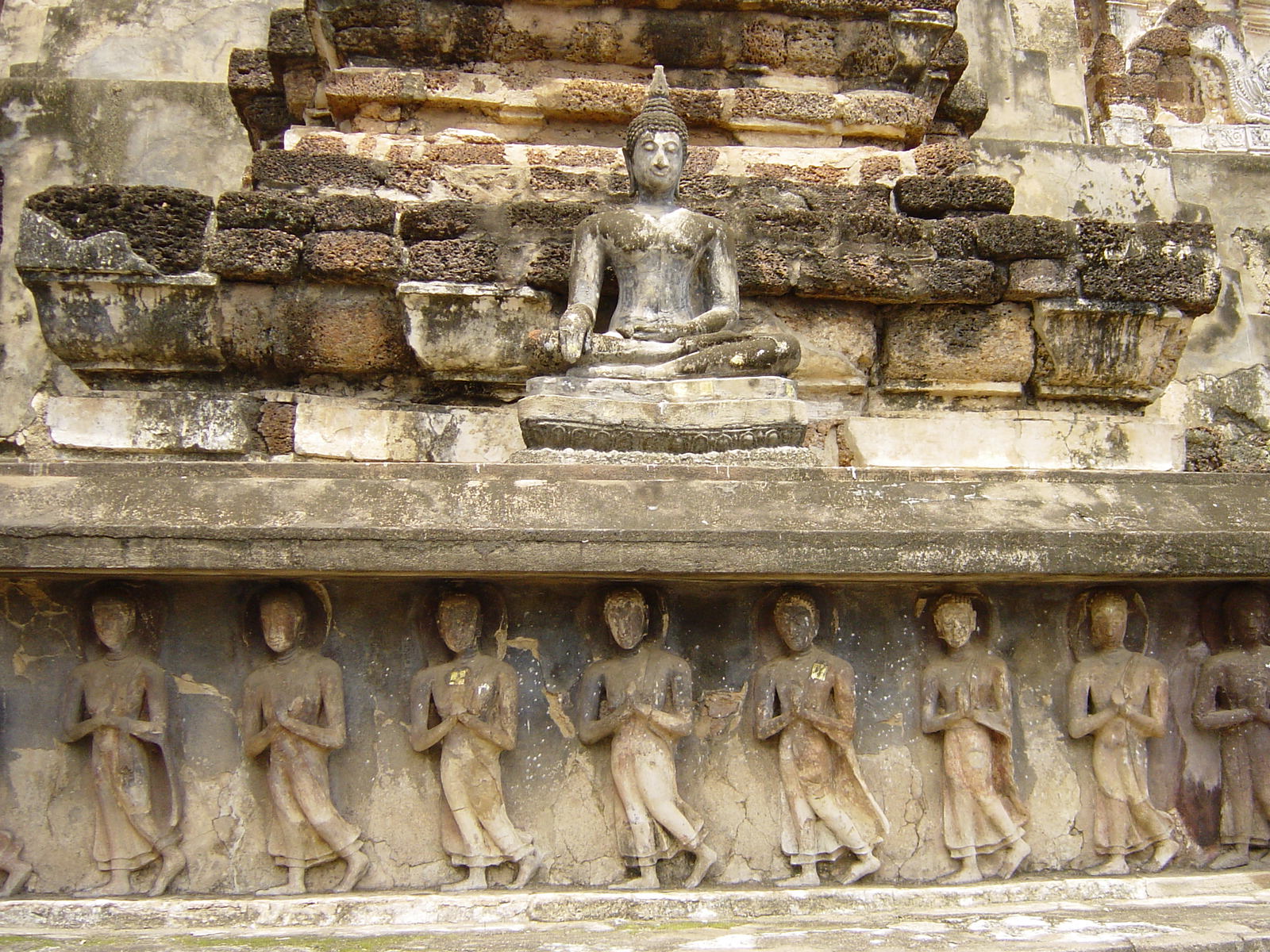Meditative postures on:
[Wikipedia]
[Google]
[Amazon]
 Meditative postures or meditation seats are the body positions or asanas, usually sitting but also sometimes standing or reclining, used to facilitate
Meditative postures or meditation seats are the body positions or asanas, usually sitting but also sometimes standing or reclining, used to facilitate
 The ''
The ''
 Sitting positions, often cross-legged, provide a stable base for
Sitting positions, often cross-legged, provide a stable base for  The lotus position in particular can be extremely uncomfortable for Westerners who have not practised sitting cross-legged since early childhood. They may, in the words of the yoga and meditation teacher Anne Cushman, be practising "self-torture ... apparently believing that bruising your inner thigh with your ankle is crucial to spiritual awakening." The pose can cause beginners knee pain and injury. Baddha Konasana is a safer alternative, provided the knees are not pushed down.
The lotus position in particular can be extremely uncomfortable for Westerners who have not practised sitting cross-legged since early childhood. They may, in the words of the yoga and meditation teacher Anne Cushman, be practising "self-torture ... apparently believing that bruising your inner thigh with your ankle is crucial to spiritual awakening." The pose can cause beginners knee pain and injury. Baddha Konasana is a safer alternative, provided the knees are not pushed down.
 Cushman notes that since meditation is not a posture, no particular posture is required. All the same, she writes, a formal method is helpful, and the asana chosen needs to be stable and comfortable, as the ''Yoga Sutras'' state: on the one side, few people would wish to hold strenuous postures like
Cushman notes that since meditation is not a posture, no particular posture is required. All the same, she writes, a formal method is helpful, and the asana chosen needs to be stable and comfortable, as the ''Yoga Sutras'' state: on the one side, few people would wish to hold strenuous postures like
 In various traditions people meditate in other postures. People who find sitting cross-legged uncomfortable can sit upright on a straight-backed chair, flat-footed and without back support, with the hands resting on the thighs, in what is sometimes called the Egyptian position.
Orthodox Christians may practice the meditation of hesychasm sitting on a stool, as was recommended by Saint Gregory of Sinai.
In various traditions people meditate in other postures. People who find sitting cross-legged uncomfortable can sit upright on a straight-backed chair, flat-footed and without back support, with the hands resting on the thighs, in what is sometimes called the Egyptian position.
Orthodox Christians may practice the meditation of hesychasm sitting on a stool, as was recommended by Saint Gregory of Sinai.
 Meditative postures or meditation seats are the body positions or asanas, usually sitting but also sometimes standing or reclining, used to facilitate
Meditative postures or meditation seats are the body positions or asanas, usually sitting but also sometimes standing or reclining, used to facilitate meditation
Meditation is a practice in which an individual uses a technique – such as mindfulness, or focusing the mind on a particular object, thought, or activity – to train attention and awareness, and achieve a mentally clear and emotionally calm ...
. Best known in the Buddhist
Buddhism ( , ), also known as Buddha Dharma and Dharmavinaya (), is an Indian religion or philosophical tradition based on teachings attributed to the Buddha. It originated in northern India as a -movement in the 5th century BCE, and ...
and Hindu
Hindus (; ) are people who religiously adhere to Hinduism. Jeffery D. Long (2007), A Vision for Hinduism, IB Tauris, , pages 35–37 Historically, the term has also been used as a geographical, cultural, and later religious identifier for ...
traditions are the lotus and kneeling
Kneeling is a basic human position where one or both knees touch the ground. Kneeling is defined as “to position the body so that one or both knees rest on the floor,” according to Merriam-Webster. Kneeling when only composed of one knee, and ...
positions; other options include sitting on a chair, with the spine upright.
Meditation is sometimes practiced while walking, such as kinhin
Walking meditation, sometimes known as kinhin ( Chinese: 經行; Pinyin: ''jīngxíng''; Romaji: ''kinhin'' or ''kyōgyō''; Korean: ''gyeonghyaeng''; Vietnamese: ''kinh hành''), is a practice within several forms of Buddhism that involve moveme ...
, doing simple repetitive tasks, as in Zen samu, or work which encourages mindfulness.
Postures in the ''Yoga Sutras''
 The ''
The ''Yoga Sutras of Patanjali
The ''Yoga Sutras of Patañjali'' is a collection of Sanskrit sutras ( aphorisms) on the theory and practice of yoga – 195 sutras (according to Vyāsa and Krishnamacharya) and 196 sutras (according to others, including BKS Iyengar). The ...
'' describe yoga as having eight limbs, one being asana, the meditation seat. The sutras do not name any asanas, merely specifying the characteristics of a good asana, stating:
The ''Sutras'' are embedded in the ''Bhasya'' commentary, which scholars including Philipp Maas now believe are by the same author; it names 12 seated meditation asanas, possibly all cross-legged, including Padmasana, Virasana, Bhadrasana
Baddha Konasana ( sa, बद्धकोणासन ; IAST: ''baddhakoṇāsana''), Bound Angle Pose, Butterfly Pose, or Cobbler's Pose (after the typical sitting position of Indian cobblers when they work), and historically called Bhadrasana, Th ...
(now called Baddha Konasana), and Svastikasana.
Sitting on the ground
 Sitting positions, often cross-legged, provide a stable base for
Sitting positions, often cross-legged, provide a stable base for meditation
Meditation is a practice in which an individual uses a technique – such as mindfulness, or focusing the mind on a particular object, thought, or activity – to train attention and awareness, and achieve a mentally clear and emotionally calm ...
, and have been used for the purpose in Buddhism and Hinduism for many centuries. These include Padmasana (full lotus), Ardha Padmasana (half lotus), Siddhasana or Muktasana (also called Burmese posture, sitting with the knees on the ground and the feet tucked in close to the body), and Sukhasana (any easy cross-legged position). Other possibilities are the kneeling postures Virasana
Virasana ( sa, वीरासन; IAST: ''vīrāsana'') or Hero Pose is a kneeling asana in modern yoga as exercise. Medieval hatha yoga texts describe a cross-legged meditation asana under the same name. Supta Virasana is the reclining form ...
(sitting between the heels) and Vajrasana Vajrasana (Sanskrit for "diamond seat" or "diamond throne") may refer to:
* The Vajrasana, Bodh Gaya, India where Gautama Buddha achieved enlightenment
* Vajrasana (yoga)
Vajrasana (), Thunderbolt Pose, or Diamond Pose, is a kneeling asana in ...
or Seiza
): "proper/correct sitting", seiza ( ja, , link=no): "quiet sitting" , Jing zuo
'' Seiza '' ( or , literally "proper sitting") is the formal, traditional way of sitting in Japan.
Form
To sit ''seiza''-style, one must first be kneeling on the ...
(sitting on the heels). Another sitting posture, Baddha Konasana (Cobbler's Pose), is suitable for people who can sit with the feet together and both knees on the ground; B. K. S. Iyengar states that to meditate in this position, the palms should be held in prayer position over the chest, which demands some practice for balance. Seymour Ginsburg, describing Gurdjieff
George Ivanovich Gurdjieff (; rus, Гео́ргий Ива́нович Гурджи́ев, r=Geórgy Ivánovich Gurdzhíev, p=ɡʲɪˈorɡʲɪj ɪˈvanəvʲɪd͡ʑ ɡʊrd͡ʐˈʐɨ(j)ɪf; hy, Գեորգի Իվանովիչ Գյուրջիև; c. 1 ...
meditation, suggests that such compact positions help the meditator to "include the entire experience of ourself in our attention."
 Cushman notes that since meditation is not a posture, no particular posture is required. All the same, she writes, a formal method is helpful, and the asana chosen needs to be stable and comfortable, as the ''Yoga Sutras'' state: on the one side, few people would wish to hold strenuous postures like
Cushman notes that since meditation is not a posture, no particular posture is required. All the same, she writes, a formal method is helpful, and the asana chosen needs to be stable and comfortable, as the ''Yoga Sutras'' state: on the one side, few people would wish to hold strenuous postures like Downward Dog
Downward Dog Pose or Downward-facing Dog Pose, also called Adho Mukha Shvanasana ( sa, अधोमुखश्वानासन; IAST: ''Adho Mukha Śvānāsana''), is an inversion asana, often practised as part of a flowing sequence of pose ...
for half an hour or more; on the other side, a restful posture like Savasana
Shavasana ( sa, शवासन; IAST: ''śavāsana''), Corpse Pose, or Mritasana, is an asana in hatha yoga and modern yoga as exercise, often used for relaxation at the end of a session. It is the usual pose for the practice of yoga nidra medita ...
(Corpse Pose) might be comfortable but would more likely lead to sleep than meditation. The cross-legged postures are simple and stable, restful for the muscles, but active enough to keep the practitioner awake. The spinal column needs to be erect and in balance; this poise lets the muscles of the back relax, and this in turn allows the attention to be focussed on the breath. These conditions can be met by a variety of postures with or without support, whether a cross-legged posture such as Muktasana, a kneeling posture, or sitting on a chair with the back vertical and the feet on the ground. The traditional support for sitting meditation is a zafu
A ''zafu'' ( ja, 座蒲, ) or ''putuan'' (, pronounced ) is a round cushion. Although also a utilitarian accessory, it is best known for its use in zazen Zen meditation.
Name
Although ''zafu'' is often translated as "sewn seat" in American En ...
cushion; this elevates the hips above the knees, allowing practitioners with stiff hips to have the spine straight and upright.
Other postures
 In various traditions people meditate in other postures. People who find sitting cross-legged uncomfortable can sit upright on a straight-backed chair, flat-footed and without back support, with the hands resting on the thighs, in what is sometimes called the Egyptian position.
Orthodox Christians may practice the meditation of hesychasm sitting on a stool, as was recommended by Saint Gregory of Sinai.
In various traditions people meditate in other postures. People who find sitting cross-legged uncomfortable can sit upright on a straight-backed chair, flat-footed and without back support, with the hands resting on the thighs, in what is sometimes called the Egyptian position.
Orthodox Christians may practice the meditation of hesychasm sitting on a stool, as was recommended by Saint Gregory of Sinai.
Theravada
''Theravāda'' () ( si, ථේරවාදය, my, ထေရဝါဒ, th, เถรวาท, km, ថេរវាទ, lo, ເຖຣະວາດ, pi, , ) is the most commonly accepted name of Buddhism's oldest existing school. The school' ...
and Zen
Zen ( zh, t=禪, p=Chán; ja, text= 禅, translit=zen; ko, text=선, translit=Seon; vi, text=Thiền) is a school of Mahayana Buddhism that originated in China during the Tang dynasty, known as the Chan School (''Chánzong'' 禪宗), and ...
Buddhists sometimes vary their sitting meditation by meditating while walking, often very slowly so as to be mindful of each movement.
Standing meditation or ''zhan zhuang
Zhàn zhuāng (站樁/站桩, ) is a training method often practiced by students of neijia (internal kung fu), such as , Xing Yi Quan, Bagua Zhang and Taiji Quan. ''Zhàn zhuāng'' is sometimes translated ''Standing-on-stake'', ''Standing Qigo ...
'' is practised in the Chinese martial art training system ''Yiquan
Yìquán, also known as Dàchéngquán, is a Chinese martial art founded by the Xìngyìquán master Wáng Xiāngzhāi (王薌齋). "Yì" (意) means Intent (but not intention), "quán" (拳) means boxing.
History
Having studied Xing Yi ...
''.
See also
*List of asanas
An asana is a body posture, used in both medieval hatha yoga and modern yoga. The term is derived from the Sanskrit word for 'seat'. While many of the oldest mentioned asanas are indeed seated postures for meditation, asanas may be standing, seat ...
* Mindful Yoga
* Yogapattasana
References
{{DEFAULTSORT:Meditative Postures Meditation *